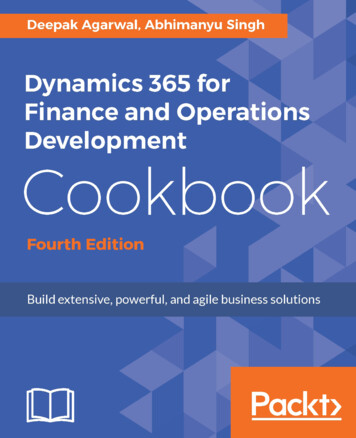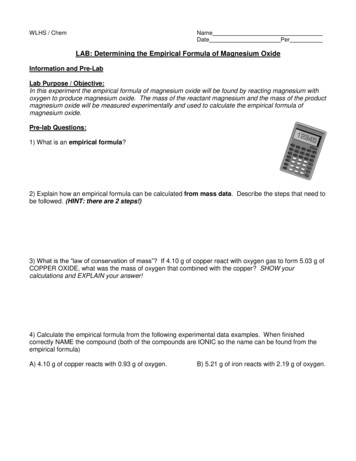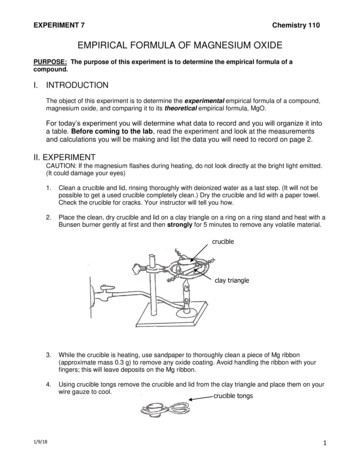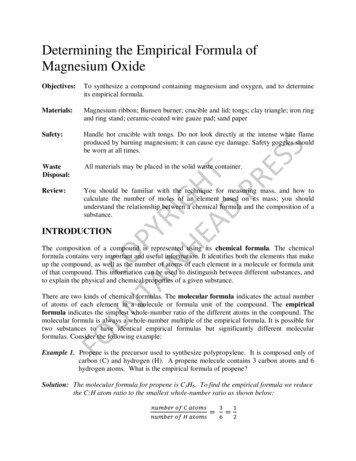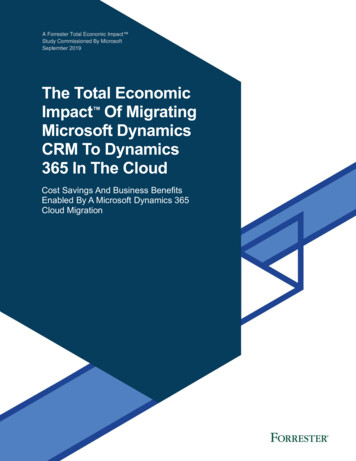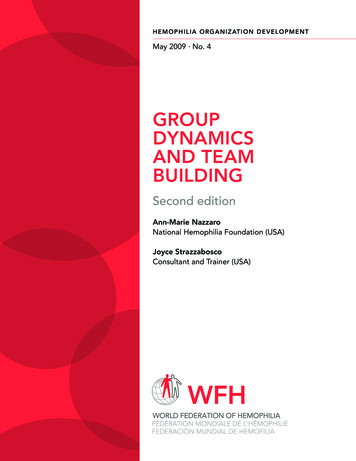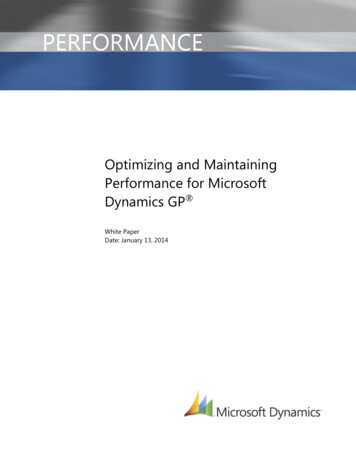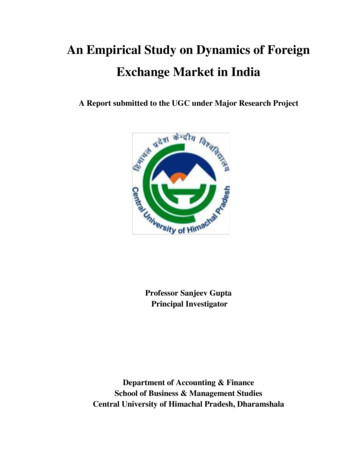
Transcription
An Empirical Study on Dynamics of ForeignExchange Market in IndiaA Report submitted to the UGC under Major Research ProjectProfessor Sanjeev GuptaPrincipal InvestigatorDepartment of Accounting & FinanceSchool of Business & Management StudiesCentral University of Himachal Pradesh, Dharamshala
PrefaceThe foreign exchange market is the largest highly and liquid financial market in the world withworldwide average daily turnover around 5.3 trillion, which makes foreign exchange highlyglobal trading asset. Foreign exchange forms the basis of dealings for trade and other monetarytransactions between economies of the world. Foreign exchange market operates withheterogeneous participants comprises of central banks, commercial banks, companies, brokers,fund managers, speculators and individuals. Central banks regulate the market for smooth andorderly operations with a broader objective of economic and financial development. On the otherhand, other participants try to minimise the potential risk with the best possible way and try tomaximise the profit. Presences of high volatility make the exposure management challenge sincethe global capital is highly volatile and purely depends on the performances in the economicfundamentals. Moreover, country-specific and market-specific investors sentiments alsoinfluence the same. This volatile pattern in the foreign exchange market is extremely crucial fora country like India which has unfavourable trade balance and facing stiff competition in theglobal market.Foreign exchange market is one of the enormous financial markets having trading centres acrossthe globe on which the sun never sets and operate in a virtual platform. It operates like otherfinancial markets where the price of the currency is measured as the value of a foreign currencyrelative to domestic currency or vice-versa. A foreign exchange contract typically states thecurrency pair, the amount of the contract, the agreed rate of exchange. Highly dynamic nature ofexchange rate necessitates and predict the behaviour for minimising the potential exposure.Understanding the foreign exchange rate movements is not only crucial for exporters and,ii
importers but also other active market participants such as commercial banks, brokers, centralbanks, traders, speculators, tourists and investors.For understanding the movements in the foreign exchange market, much emphasis is given onfundamental, behavioural, technical analysis along with central bank’s actions for currencymanagement. Fundamental analysis involves the study of economic fundamentals of a countrysuch as Gross Domestic Product (GDP), Balance of Payment (BOP) Position, Political Stability,Inflation, Interest Rates and Rating by major Global Credit Rating Agencies etc. Nonfundamental factors play an inevitable role as the market not always consensus withfundamental, but it has strong relations with sensitive factors. Behavioural factor like bandwagoneffects, peers/social and rumours influence the participant's decision. Similarly, technicalanalysis uses exchange rate forecasting techniques based on historical movements in the market.Impact of fundamental and non-fundamental factors on the foreign exchange market has becomea widely studied topic in academic literature. One side of this literature focuses on the impact offundamental and non-fundamental factors, while the other on the role, efficiency and use oftechnical analysis by foreign exchange traders in generating trading signals. Some studies havereported from their survey of foreign exchange traders that non-fundamental factors such asbandwagon effects, over-reaction to news, technical trading, and excessive speculationdetermines short-run exchange rate and the role of fundamental factors in relevant in the longrun. Previous literature on technical analysis provides that technical analysis is an important andwidely used method of analysis in the foreign exchange market and that applying certaintechnical trading rules over a sustained period may lead to significant positive excess returns.Most of these studies have however been limited to major developed countries and someiii
developing countries excluding India. These results might differ between the countries as itdepends on the specific country’s market regulations, ‘maturity’ and the economy itself.Motives for central bank interventions in the foreign exchange market are clearly available andsupported by the academic literature. But the impact of central bank interventions on foreignexchange volatility and its relationship with technical rules profitability is still unclear. Somestudies on a survey of foreign exchange dealers have reported that central bank intervenes withthe objective to bring stability in the market have an intervention which reduces volatility;whereas other studies have reported from their survey evidence that central bank interventionsincrease volatility in the market. This contradiction needs to be addressed and has aroused thenecessity to identify the existent impact of central bank interventions on foreign exchangevolatility so that behaviour of the market to intervention practices can be understood clearly.Studies on central bank interventions and technical trading rules profitability provides thattrading rules are unusually profitable on days on which interventions take place, so the sameneeds to be investigated in the Indian context.This study primarily investigates the dynamic characteristics of Indian foreign exchange marketincluding perception and attitude of the market participants to forecasting the exchange rate withan artificial neural network technique. It specifically examines the relative importance offundamental as well non-fundamental that influence foreign exchange rate predictions and theirtime-varying behaviour in the market. Similarly, it explores the significance of fundamental andnon-fundamental factors in the trading decision of foreign exchange traders. Study tries todiscover an appropriate model to forecast the exchange rate movements of INR-USD; INR-GBP,INR-JPY and INR-EUR. Further study assesses the impact of central bank interventions bymeasuring the extent of the volatility of the Indian foreign exchange market due to Central Bankiv
interventions. Finally, study recommend measures for policy makers, investors and corporate onthe basis of the findings from the present study.Following the sanctioning of the project by the project by the University Grants Commission,the study was carried out in multiple directions. The study used both primary and time series datafor analysing the dynamics of the Indian foreign exchange market. Samples or the primaryanalysis were collected from major north Indian cities like Delhi, Chandigarh, Amritsar,Jalandhar and Ludhiana based on the highest number of registered foreign exchange brokers.Using a purposive sampling technique, a non-disguised structured questionnaire wasadministered to collect data from 250 respondents across five cities.content validity ofquestionnaire items were ensured after a detailed discussion with two experts’ having more than20 years of experience in the foreign exchange market and two professors from the academicfield. After four revisions consensus was formed among the suggestions of experts from twofields and questionnaires were administered on 60 brokers from Ludhiana. After a gap of 20days’ questionnaire was again administered to same 60 brokers.Heterogeneous respondents include 58 dealers registered with Reserve Bank of India, 94brokers/sub-brokers registered with Securities and Exchange Board of India and 96 investorsfrom different cities. From each city, major trading locations were identified, and respondentswere targeted accordingly. One investor from each broker office was selected based on highesttrading experience. Time series data on exchange rate, central bank intervention, and othereconomic variables at different frequencies were collected from RBI, Federal reserve, andinternational monetary fund. For analysing, modelling and interpreting the primary andsecondary data consistent with stated objectives, various statistical, econometric and artificialv
intelligence tools and techniques have been employed with the help of software like SPSS,GPower, E-views (Student Version), Statistica (Courtesy NIT, Jalandhar) and Microsoft Excel.Study discovered some interesting points on the determination of foreign exchange rate in Indianmarket. Exchange rate determination through fundamental factors was significantly higher thantechnical and behavioural factors. Similarly, fundamental factors have greater ability todetermine foreign exchange rate than speculation. However, the usefulness of a factor may varyfor prediction of trends and turning points. The trend prediction results revealed that fundamentalfactors were considered somewhat more useful in predicting trends than predicting turning pointsin the foreign exchange market. Study discovered that broker/sub-broker views regarding theeffect of speculation on increase in exchange rate volatility were significantly higher than dealergroup and investor group. Investor views regarding the effect of speculation on increase inexchange rate volatility were significantly higher than dealer group. However, no significantdifference was found in the views of broker/sub-broker group and investor groupCentral bank intervenes in the foreign exchange market to achieve multiple objectives such ascontrolling inflation, boost growth, maintaining international competitiveness, preventingdisorderly market condition, reserve accumulation and upholding internal and external balanceThere are several techniques to intervene in the foreign exchange market such as Concerted,Sterilized, Scheduled, Spot Market and Forward Market interventions depending on theobjective, country and time of intervention. Survey result found that foreign exchange tradersprofoundly believe that central bank interventions affect the foreign exchange rate. But tradersdisagree with the statement that central bank interventions have an influence on profits forchartists in short term, dealer and investor group disagreed, and broker/sub-broker disagreed tothe statement. Time series data reveal the presence of leaning against wind policy of RBI tovi
manage the exchange rate uncertainties. However, RBI intervention is capable of minimizing theexchange rate volatility though it failed to influence exchange rate.I, author of the report, owe gratitude to individuals and functionaries of the university whoplayed an important role right from the writing of the project proposal till the completion andsubmission of the project report otherwise it would not be possible (and we would be failing inour duties if we do not acknowledge their help and support). To begin with, we owe a deepsense of gratitude to Professor Furqan Qamar, the founder Vice-Chancellor of the centraluniversity of Himachal Pradesh, Dharamshala who encouraged principal investigator to developand submit the project proposal to the University Grants Commission (UGC) for funding, whilehe was in the university he took particular interest to ensure adequate facility for the systematicandsmooth execution of the project. I express my heartful thanks to our present Vice-Chancellor prof Kuldeep Chand Agnihotri who promptly addressed all our problems wheneverthese were brought to his notice. I also grateful to Prof H. R. Sharma, pro-vice chancellor for hishelp at every stage of the implementation of the project. I am also grateful to Prof. Y.S.Verma,former pro-vice chancellor and Dean, School of Business and Management Studies for hisimmeasurable patronage and inspiration. My collegues in the Department of Accounting andFinance namely Dr Mohinder Singh, Dr Manpreet Arora, and Dr Ashis Nag have always beenvery supportive and helpful and deserve my profound appreciations and sincere thanks. I alsoappreciate Dr Jagdish Raj Saini, Dr Sachin Kashyap, Mr Abdul Rishad, and Mr Akhil Sharma,Research Scholars, who accomplished various tasks like designing, collecting and analysingdata, and preparing the report with great commitment and devotion in their meticulous work.I am incredibly grateful to Mr Munish Sharma, research assistant, unconditionally helped invarious phases of this project. We also remain indebted to our respondents from Delhi,vii
Chandigarh, Amritsar, Jalandhar and Ludhiana for their complete and sincere involvement in thestudy, otherwise, it would not have been possible to complete within the time frame and thankfulto National Institute of Technology (Jalandhar) for their technical support. I further wish to puton record my appreciation to the Registrar and Finance officer of the university for facilitatingsmooth implementation of the project. The secretarial assistance rendered by Mr Sandeep Singh,LDC and Mr. Munish, finance department for their support and assistance from the beginning tillthe completion and submission of the project report is highly appreciated and gratefullyacknowledged. In the end, I also wish to acknowledge the financial support provided by theUniversity Grants Commission for undertaking the study.viii
.91.101.111.122.2.12.22.32.43.INTRODUCTIONHistory Events in the Foreign Exchange MarketForeign Exchange Market Key AttributesNature of Indian Foreign Exchange MarketGrowth of Foreign Exchange Market in India.Structure of Indian Foreign Exchange MarketFundamental AnalysisTechnical AnalysisBehavioural FactorsCentral Bank InterventionsNeed and Significance of the StudyObjectives of the StudyStructure of the Study1-252337815161719202121-22REVIEW OF LITERATUREStudies Associated to Survey of TradersStudies Related to Fundamental and TechnicalAnalysisStudies Related to Central Bank InterventionsStudies Related to Forecasting26-5626-2929-3131-4040-49DATABASE AND ANALYTICAL TOOLSPrimary DataPopulation of the StudyData CollectionHypothesis of the StudyAnalysis of Primary DataSecondary Data57-865757-5858-6363-6565-7070-82FUNDAMENTAL AND NON-FUNDAMENTALFACTORS: AN EMPIRICAL ANALYSIS4.1Analysis of Difference in Fundamental and NonFundamental Factors Ability to DetermineExchange Rate4.2Analysis of Difference in Success Rate AchievedThrough Fundamental and Non- FundamentalFactors4.3Analysis of Difference in the Ability ofFundamental Factors (Constituents) to InfluenceForeign Exchange Rates4.4Analysis of Difference in The Ability ofTechnical Factors (Trading Techniques) toPredict Turning Points in Foreign 7-9091-949497-100
4.5Analysis of Difference in the Ability ofTechnical Factors (Trading Techniques) toPredict Trends in Foreign Exchange RatesAnalysis of Difference in the Ability ofBehavioural Factors to Influence ForeignExchange Trading Decisions of TradersAnalysis of Difference in the Views of ForeignExchange Traders Regarding Effect ofSpeculation on Increase in Exchange RateVolatilityAnalysis of Difference in the Views of ForeignExchange Traders Regarding Effect ofSpeculation on Movement of Exchange RateAway from their Fundamental LevelsAnalysis of Difference in the Views of ForeignExchange Traders Regarding Effect ofSpeculation on Increase in Liquidity in ForeignExchange MarketAnalysis of Difference in the Views of ForeignExchange Traders Regarding Effect ofSpeculation on Improvement in MarketEfficiency.100-104IMPACT OF CENTRAL BANK INTERVENTIONS:AN EMPIRICAL VERIFICATION5.1Descriptive Statistics for Central BankInterventions5.2Analysis of Difference in the Views of ForeignExchange Traders Regarding Effect of CentralBank Interventions on Foreign Exchange Rate5.3Analysis of Difference in the Views of ForeignExchange Traders Regarding Effect of CentralBank Interventions on Exchange Rate Volatility5.4Analysis of Difference in the Views of ForeignExchange Traders Regarding Central BankInterventions Move Exchange Rate Away fromtheir Fundamental Levels5.5Analysis of Difference in the Views of ForeignExchange Traders Regarding Central BankInterventions are Conducted at AppropriateMoment5.6Analysis of Difference in the Views of ForeignExchange Traders Regarding Central BankInterventions Achieve the Desired Goal122-139INTERVENTIONS, EXCHANGE RATE 38VOLATILITY6.1Motives for Interventionx140-141
6.26.36.46.57.7.17.28.8.18.28.38.48.5Channels of InterventionRBI InterventionUnit Root TestResult of the GARCH ModelFORECASTS AND APPROPRIATENESSResults and DiscussionConclusionSUMMARY AND CONCLUSIONIntroductionReview of LiteratureDatabase and MethodologyFinding of the StudyRecommendations of the 189-195195-203i-xxxiiii-vii
LIST OF FIGURESFIGURENO.TITLEPAGENO.Structure of a NeuronArtificial Neural Network ArchitectureNeural Network Processing StageLinear FunctionLogistic FunctionHyperbolic Tangent FunctionExponential FunctionSine FunctionPredictability of market trend over different time horizonsImportance of data in predicting trendsPredictability of foreign exchange in the presence of centralbank interventions.75767677777878791031041215.2 Influence of interventions on exchange rate over different timeperiods6.1 RBI Intervention and Exchange Rate Movement.6.2 Reserve Accumulation and Exchange Rate Movement6.3 Exchange Rate Returns6.4 Conditional volatility.7.1 Comparison between the actual and predicted values in case ofUSD, GBP, EURO and .84.14.25.1xii
LIST OF TABLESTABLENO.TITLE1.1Growth of foreign exchange trading (currency trading) inIndia1.2 List of Authorised Dealers in Category-I1.3 List of Authorised Dealers in Category-II1.4 List of Authorised Dealers in Category-III1.5 Public sector banks1.6 Foreign banks1.7 Private Sector Banks / Co-op Banks1.8 Financial institutions / others3.1 Reliability coefficients of constituents of factors affecting theforeign exchange rate.PAGENO.7-810-1111-121213-141414-151558-593.2 Reliability coefficients of factors determining the foreignexchange rate3.3 Reliability coefficients of statements related to the effect ofspeculation on the exchange rate.593.4 Reliability coefficients of the usefulness of fundamentalanalysis and technical analysis in predicting trends andturning points.603.5 Reliability coefficients of success rate achieved in foreignexchange trading on the basis of factors3.6 Reliability coefficients of statements related to the effect ofcentral bank interventions on the foreign exchange rate.603.7 Current Position of foreign exchange traders3.8 Trading Experience of foreign exchange traders.3.9 Gender of foreign exchange traders.61626259613.10 Age of foreign exchange traders.3.11 Educational Qualification of foreign exchange traders.62-63633.12 Guidelines for interpretation of effect size (Cohen, 1988).4.1 Paired samples descriptive statistics for difference ability offundamental and non-fundamental factors to determine theexchange rate.6987-884.2 Paired samples test for difference ability of fundamental andnon-fundamental factors to determine the exchange rate4.3 Importance of factors affecting foreign exchange rate overdifferent forecast horizons.88-894.4 Paired samples descriptive statistics for the difference insuccess rate achieved through fundamental and nonfundamental factors91-92xiii90
4.5 Paired samples test for difference in success rate achievedthrough fundamental and non-fundamental factors.4.5.1 Descriptive statistics for constituents of fundamental factors4.6 Mauchly's test of sphericity for the difference in the ability offundamental factors to influence the foreign exchange rate.4.7 Tests of within-subjects effects for the difference in theability of fundamental factors to influence the foreignexchange rate.4.8 Multivariate tests for difference in the ability of fundamentalfactors to influence the foreign exchange rate4.9 Importance of fundamental factors affecting foreignexchange rate over different forecast horizons4.10 Descriptive statistics for technical factors ability to predictturning points in foreign exchange rates.4.11 Mauchly's test of sphericity for the difference in the ability oftechnical factors to predict turning points in foreign exchangerates.92-939495959696-9798994.12 Tests of within-subject’s effects for the difference in theability of technical factors to predict turning points in foreignexchange rates.994.13 Multivariate Tests for the difference in the ability of technicalfactors to predict turning points in foreign exchange rates4.14 Descriptive statistics for technical factors ability to predictthe trend in foreign exchange rates.1001001014.15 Mauchly's test of sphericity for the difference in the ability oftechnical factors to predict trends in the foreign exchangemarket4.16 Tests of within-subject’s effects for the difference in theability of technical factors to predict trends in the foreignexchange market4.17 Multivariate tests for difference in the ability of technicalfactors to predict trends in the foreign exchange market4.18 Descriptive statistics for behavioural factors ability toinfluence foreign exchange trading decisions of traders.1014.19 Mauchly's test of sphericity for the difference in the ability ofbehavioural factors to influence foreign exchange tradingdecisions of traders.1054.20 Tests of within-subject’s effects for the difference in theability of behavioural factors to influence foreign exchangetrading decisions of traders.1064.21 Multivariate tests for difference in the ability of behaviouralfactors to influence foreign exchange trading decisions of106xiv102102105
traders.4.22 Descriptive statistics for the views of foreign exchangetraders regarding the effect of speculation on increase inexchange rate volatility.1074.23 Kruskal Wallis test statistics for views of foreign exchangetraders regarding the effect of speculation on increase inexchange rate volatility.4.24 Ranks for the dealer and broker/sub-broker group regardingthe effect of speculation on increase in exchange ratevolatility.1084.25 Mann-Whitney tests statistics for the difference in the viewsof traders regarding the effect of speculation on increase inexchange rate volatility4.26 Descriptive Statistics for the views of foreign exchangetraders regarding the effect of speculation on the movementof exchange rate away from their fundamental levels.1094.27 Test of Homogeneity of Variances for the views of foreignexchange traders regarding the effect of speculation on themovement of exchange rate away from their fundamentallevels.4.28 ANOVA for the views of foreign exchange traders regardingthe effect of speculation on the movement of exchange rateaway from their fundamental.4.29 Tukey HSD tests for the views of foreign exchange tradersregarding the effect of speculation on the movement ofexchange rate away from their fundamental levels4.30 Descriptive Statistics for the views of foreign exchangetraders regarding the effect of speculation on increase inliquidity in the foreign exchange market4.31 Test statistics for the views of foreign exchange tradersregarding the effect of speculation on increase in liquidity inthe foreign exchange market.4.32 Ranks for the dealer and broker/sub-broker group regardingthe effect of speculation on increase in liquidity in the foreignexchange market.4.33 Mann-Whitney tests statistics for the difference in the viewsof traders regarding the effect of speculation on increase inliquidity in the foreign exchange market4.34 Descriptive statistics for the views of foreign exchangetraders regarding the effect of speculation on improvement inmarket efficiency4.35 Test of homogeneity of variances for the views of foreignexchange traders regarding the effect of speculation onimprovement in market efficiency.1124.36 ANOVA for the views of foreign exchange traders regardingxv109111112112113114115115116117118118
the effect of speculation on improvement in market efficiency5.1 Descriptive Statistics for the views of foreign exchangetraders regarding the effect of central bank interventions onthe foreign exchange rate.1235.2 Kruskal Wallis Test Statistics for views of foreign exchangetraders regarding the effect of central bank interventions onthe foreign exchange rate.5.3 Descriptive Statistics for the views of foreign exchangetraders regarding the effect of central bank interventions onexchange rate volatility.1245.4 Kruskal Wallis Test Statistics for the views of foreignexchange traders regarding the effect of central bankinterventions on exchange rate volatility5.5 Ranks for Dealer and Broker/Sub Broker Group regarding theeffect of central bank interventions on exchange ratevolatility5.6 Mann-Whitney tests Statistics for the difference in the viewsof traders regarding the effect of central bank interventionson exchange rate volatility.1265.7 Descriptive Statistics for the views of foreign exchangetraders regarding central bank interventions moves exchangerate away from their fundamental levels5.8 Kruskal Wallis Test Statistics for the views of foreignexchange traders regarding central bank interventions movesexchange rate away from their fundamental levels.1291251271271291305.9 Ranks for Dealer and Broker/Sub Broker Group regardingcentral bank interventions moves exchange rate away fromtheir fundamental levels.1305.10 Mann-Whitney tests Statistics for the difference in the viewsof traders regarding central bank interventions movesexchange rate away from their fundamental levels.1301315.11 Descriptive Statistics for the views of foreign exchangetraders regarding central bank interventions are conducted atan appropriate moment5.12 Test of Homogeneity of Variances for the views of foreignexchange traders regarding central bank interventions areconducted at an appropriate moment5.13 ANOVA for the views of foreign exchange traders regardingcentral bank interventions are conducted at an appropriatemoment5.14 ANOVA Tests for the views of foreign exchange tradersregarding central bank interventions are conducted at anappropriate moment.132xvi133133133
5.15 Contrast Coefficients for the views of foreign exchangetraders regarding central bank interventions are conducted atan appropriate moment.1345.16 Tukey HSD Tests for the views of foreign exchange tradersregarding central bank interventions are conducted at anappropriate moment.5.17 Descriptive Statistics for the views regarding central bankinterventions achieve the desired goal.1345.18 Test of Homogeneity of Variances for the views of foreignexchange traders regarding central bank interventions achievethe desired goal5.19 ANOVA for the views of foreign exchange traders regardingcentral bank interventions achieve the desired goal.1365.20 Robust Tests of Equality of Means for the views of foreignexchange traders regarding central bank interventions achievethe desired goal.1365.21 Contrast Coefficients for the views of foreign exchangetraders regarding central bank interventions achieve thedesired goal.5.22 Tukey HSD Tests for the views of foreign exchange tradersregarding central bank interventions achieve the desired goal.1376.1 Descriptive Statistics6.2 ARCH Test6.3 Unit Root Test6.4 Empirical Result7.1 Sum of squared error and Root mean square error of differentmultilayered perceptron models of USD, GBP, EURO andJPY7.2 Best model amongst the different multilayered perceptronmodels of USD, GBP, EURO and JPY.1351361371471481491521531541641711731747.3 Ranking of the best-multilayered perceptron models of USD,GBP, EURO and JPY.1741757.4 Out of sample forecasts of USD, GBP, EURO and JPY on thebasis of best neural models.178179xvii
IntroductionThe foreign exchange market is the generic term for the worldwide institutions thatexist to exchange or trade currencies. Foreign exchange is often referred to as “forex” or“FX.” The foreign exchange market is an over-the-counter (OTC) market, which meansthat there is no central exchange and clearinghouse where orders are matched (Lien,2009). FX dealers and market makers around the world are linked to each other aroundthe clock via telephone, internet links, and fax, creating one cohesive market.Undoubtedly, we are now living in a world where all the major economic functionsconsumption, production, exchange and investment are highly globalized. India importsugar and sugar confectionery from Brazil, Thailand, Guatemala and Spain. Americanconsumers, for example, routinely purchase oil imported from Saudi Arabia and Nigeria,TV sets from Korea, automobiles from Germany and Japan, garments from China, shoesfrom Indonesia, pasta from Italy, and wine from France. Foreigners, in turn, purchaseAmerican-made aircraft, software, movies, jeans, wheat, and other products. Continuedliberalization of international trade is certain to further internationalize consumptionpatterns around the world (Eun & Resnick, 2012). It is thus essential for financialmanagers to fully understand vital international dimensions of currency risk involved insettlement of these trades and the available tools for its management.Understanding the foreign exchange rate movements is not only important forexporters and, importers but also for those who deal in currency market regularly such as,commercial banks, brokers and central banks, traders and speculators, tourists and investors, etc.The exchange of currencies is done in the foreign exchange market, which is one of thebiggest financial markets having trading centres in each part of a single world on whichthe sun never sets (Krugman, Obstfeld, & Melitz, 2012). The foreign exchange rate is thevalue of a foreign currency relative to domestic currency. A foreign exchange contracttypically states the currency pair, the amount of the contract, the agreed rate of exchangeetc.For understanding the movements i
Study discovered some interesting points on the determination of foreign exchange rate in Indian market. Exchange rate determination through fundamental factors was significantly higher than technical and behavioural factors. Similarly, fundamental factors have greater ability to determine

